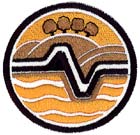Bucknell
Bucknell is a briskly-danced tradition: ‘brisk and jerky’ according to the Black Book and ‘necessitates a high degree of precision if it is not to be ugly’.
DDMM do just one Bucknell dance at the moment (2025) - The Willow Tree - as learned from Cambridge Morris Men, during the 1980s.
Last updated 2 February 2025
Return to Introduction page
The Willow Tree
NB to start with! This is a dance collected several times in the early days of the Morris revival, and interpreted differently over the years. Thus different sides do it differently, particularly when it comes to the hey and the side-step, and in other smaller ways too. YouTube videos are to be interpreted with care!
Stepping is based on double step (DS), left foot start (many sides start right foot), ‘DS sequence’ is: 2 bars DS followed by two hop backs (as Fieldtown), then Feet-together-jump (FtJ). The hands are distinctive: a ‘quick-down’ or ‘snatch’ movement. ‘Starts about 12 inches in front of the chin’ (Black Book) – no higher - then pulled down very sharply with a jerk – if you can make the hankies snap so much the better. The action of pulling the handkerchiefs down works from the elbows, and it’s easier if the backs of your hands are uppermost. The hands should not go back past the seams of your trousers. In hop backs, the hands are held out sideways in balance. In FtJ hands go up but not so far that it is difficult to start the quick-down from the right position.
The Willow Tree Distinctive Figure (DF) Is a ‘long’ open sidestep left (ossl) – left-foot start (many sides do closed sidestep, right-foot start), followed by long oss to the right (ossr), then a half-hey. The feet in long sidestep = open sidestep left (or right) followed by a bar of DS (like the Fieldtown long sidestep). The hands: in the oss the hand (left in first oss, right in second oss) goes up as high as you can, to form a contrast with the quick-down of the hands in the following DS. SS hand needs to be pulled down fast enough to be ready for the ensuing quick-down. There’s no FtJ in the DF.
On the final two notes of the DS in the ossr sequence, the tops turn to face down ready to go straight into the hey. Middles and bottoms turn to face up the set.
The Bucknell hey Think Ilmington hey without the turns. All have 3 bars to get to new place, 4th bar is FtJ
Tops go straight down the set midline, then outwards, ending up a foot or two outside the set line, somewhere between where middle and bottom couples used to be, facing outwards. They pause, then back into place (easy way) on hop backs.
Middles go outwards to get out of the way, up the outside of the set, then back inwards towards the centre line, at about top couple level. They pause, then hop back side-by-side into place in the middle.
Bottoms pause, then dance swiftly up the middle of the set then outwards, ending up a foot or two outside the set line, somewhere between where middle and top couples used to be, facing outwards. They then back into place (easy way) on hop backs.
The pause. Each couple pauses during the hey as described above, before all three couples hop back and FtJ in unison. How long is the pause? Approximately 2 beats, long enough to be sure that the way ahead is clear.
The Common figures
Once to yourself: FtJ
Foot-up / down: DS sequence. Complete the Ftj facing forwards. Turn to foot down on first note of the next DS sequence. At the end, on Ftj, turn to face across ready to start the DF
Cross over: DS sequence. Cross right shoulders, turn sharply right to go belly-to-belly, then hops back out. Repeat (right shoulders again), returning to place ready for DF. Just like the equivalent in Headington
Back-to-back: DS sequence, backing on the hop backs into a line down the centre of the set, before the FtJ. Hands out in balance on the hop backs help ensure the line is straight. 2nd half, retrace path back to place
Rounds: clockwise, 2 bars DS, then tight cw turn 360 degrees on the spot on 1 bar of DS, then FtJ . Continue round cw for 2 more bars DS, then turn out (ie counter cw) on 4 capers, as much on the spot as possible (hands doing low wide twists), punch in towrds the centre to finish.
